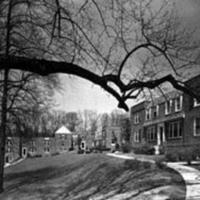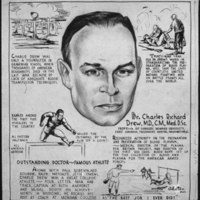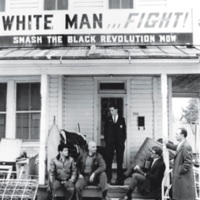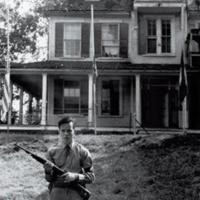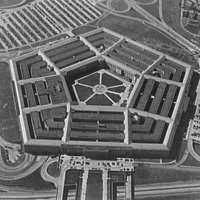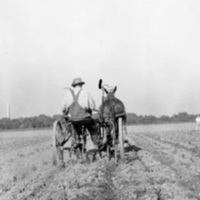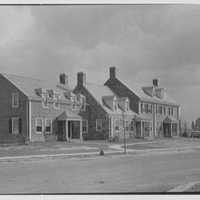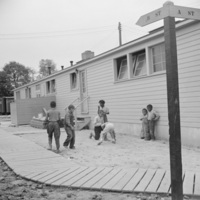Browse Items (20 items total)
Colonial Village is a garden-style apartment complex created by professional developer Gustave Ring in 1935. It contains more than 200 Colonial Revival red brick buildings surrounded by landscaped paths and lawns.
The development was created to help house the huge number of recently arrived federal employees using funds from the Federal Housing Administration (FHA). The Colonial Village complex was one of the first developments to work with the FHA and Ring helped shape their policies.
The development was created to help house the huge number of recently arrived federal employees using funds from the Federal Housing Administration (FHA). The Colonial Village complex was one of the first developments to work with the FHA and Ring helped shape their policies.
Collection: Neighborhoods
Charles Drew was an African American surgeon and scientist whose pioneering work with blood plasma and transfusions saved countless lives during World War II. He ultimately left military service after the US Government attempted to segregate blood donations without any scientific need for such a policy. Drew served as a Professor at Howard University, the chief surgeon at Freedmen's Hospital, and became the first African American examiner for the American Board of Surgery. He died in a car accident in 1950 at the age of 45, leaving behind his wife Minnie and four children.
Collection: Civil Rights
In 1960 the American Nazi Party protested Mario's Pizza because it was owned by long-time Arlington resident Howard Levine, a Jewish-American. In this photo, George Rockwell holds up a protest signs in front of the pizzeria.
Many of the group's protests and demonstrations centered on local Arlington issues. The group was also actively involved in county government and school board affairs. From their base in Ballston, group activities sometimes focused on national events by engaging in counter-protests and intimidation campaign for Civil Rights activities, such as following the route of the Freedom Riders throughout the South in 1965.
Many of the group's protests and demonstrations centered on local Arlington issues. The group was also actively involved in county government and school board affairs. From their base in Ballston, group activities sometimes focused on national events by engaging in counter-protests and intimidation campaign for Civil Rights activities, such as following the route of the Freedom Riders throughout the South in 1965.
Collection: Civil Rights
The American Nazi Party was founded in Arlington County in 1958 by George Lincoln Rockwell. Rockwell was born in Bloomington, Illinois in 1918, educated at Brown University and the Pratt Institute of Art in Brooklyn, and served as a Navy pilot in WWII and Korea. Inspired by Hitler, Rockwell blended German fascism with American racism. He and his organization protested local and national Civil Rights activities, picketed businesses, and held white-pride events. They were also very active in politics. In this photo Rockwell attends a School Board meeting to work again school integration. He was assassinated in Arlington in 1967 by fellow Nazi party member John Patler over control of the organization.
Collection: Civil Rights
The American Nazi Party was founded in Arlington, Virginia by George Rockwell in 1958. The group was headquartered out of Arlington's Ballston neighborhood. The Arlington chapter had 50 to 60 members active in the late-1950s and early-1960s. From this headquarters the group organized protests, demonstrations, and political activities. In this photograph, Nazis sit on the front porch of their offices on Randolph Street, purchased for them by Floyd Fleming.
Collection: Civil Rights
The American Nazi Party was founded in Arlington County by George Rockwell in 1958. The Arlington chapter of the American Nazi Party had 50 to 60 members active in the late-1950s and early-1960s. Most of these members lived together in a late-Victorian home they used as a barracks on Wilson Boulevard in Clarendon. Local sympathizers not directly affiliated with the group showed their support by bringing the men food to this home during the winter. While some residents complained of the “sieg heil” salutes given by their new neighbors in greeting, the Nazis did not actually break any community or county laws. Many came to call this property "Hatemonger Hill."
Collection: Civil Rights
In 1941 the War Department began building their headquarters, known as the Pentagon, in Arlington. The Pentagon was one of the first federal buildings constructed outside of downtown Washington. The Pentagon's 3.6 million square feet of office space took just over a year to complete at a cost of $75 million.
The unique pentagon shape of the building was chosen so that the building could fit between Arlington Memorial Drive, Arlington Memorial Bridge, National Cemetery, Arlington Ridge Road, and Fort Myer. Though this location was deemed unsuitable for the building, the pentagonal shape remained. The Pentagon's construction led to the destruction of the nearby Queen City African American community.
The unique pentagon shape of the building was chosen so that the building could fit between Arlington Memorial Drive, Arlington Memorial Bridge, National Cemetery, Arlington Ridge Road, and Fort Myer. Though this location was deemed unsuitable for the building, the pentagonal shape remained. The Pentagon's construction led to the destruction of the nearby Queen City African American community.
Collection: Government, Law, & Politics
On land which had once been Arlington Tract Farms, the farming portion of the Freedman’s Village community, the Department of Agriculture created an expansive farm for testing new crops and farming techniques. Known as the Experimental Farm, this facility was created in 1913 between the Butler-Holmes and Johnson’s Hill’s communities. The farm provided Arlingtonians the opportunity to continue to work as farmers long after the region changed from rural to suburban. In 1940 the farm relocated to Maryland to make room for the War Department's building project, which would ultimately use other nearby land upon which to build the Pentagon.
Collection: Government, Law, & Politics
In 1941 the Defense Homes Corporation (DHC), a subsidiary of Roosevelt's National Housing Agency, purchased 322 acres to develop housing for war-time personnel. Named Fairlington, the community featured 3,449 garden apartments. It was the largest project undertaken by the DHC and was the largest apartment complex in the nation upon its completion.
Designed by architects Kenneth Franzheim and Allen B. Mills, the community features Colonial Revival brick buildings which incorporate shared green space and non-grid cluster patterns in building layout.
After the war Fairlington transitioned from public to private ownership and was successfully converted to a condominium community. Despite a proposal to level the community in favor of high-rise housing in the 1960s, Fairlington remains Arlington's largest selection of moderate-income housing.
Designed by architects Kenneth Franzheim and Allen B. Mills, the community features Colonial Revival brick buildings which incorporate shared green space and non-grid cluster patterns in building layout.
After the war Fairlington transitioned from public to private ownership and was successfully converted to a condominium community. Despite a proposal to level the community in favor of high-rise housing in the 1960s, Fairlington remains Arlington's largest selection of moderate-income housing.
Collection: Neighborhoods
In 1942 the federal government created emergency wartime housing to assist African American residents from Queen City displaced by the construction of the Pentagon. They constructed a trailer camp on mud flats on the outskirts of the Green Valley neighborhood. Entire families squeezed into trailers equipped with stoves for heat and cooking, convertible couch-beds meant to sleep four people, and no running water. The trailer camp was closed shortly after the war.
Collection: Neighborhoods
